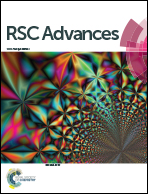Photocytotoxic luminescent lanthanide complexes of DTPA–bisamide using quinoline as photosensitizer†
Abstract
Lanthanide complexes [Ln(DTPAAQ)(DMF)] (1–3) (Ln = Pr (1), Eu (2), Tb (3), H3DTPAAQ = N,N′′-bis(3-amidoquinolyl) diethylenetriamine-N,N′,N′′-triacetic acid, DMF = N,N-dimethylformamide) were studied for their structures, photophysical properties, DNA and protein binding, DNA photocleavage, photocytotoxicity and cellular internalization. The crystal structures of complexes [Ln(DTPAAQ)(DMF)] (1–3) display a discrete mononuclear nine-coordinate {LnN3O6} tricapped-trigonal prism (TTP) coordination geometry. The europium and terbium complexes show strong luminescence properties in the visible region having a long luminescence lifetime (τ = 0.51–0.64 ms). The conjugated 3-aminoquinoline moieties act as efficient light harvesting antennae, which upon photoexcitation transfer their energy to Eu(III) or Tb(III) for their characteristic 5D0 → 7FJ or 5D4 → 7FJ f–f transitions respectively. The complexes display efficient binding affinity to DNA (Kb = 3.4 × 104 − 9.8 × 104 M−1) and BSA (KBSA = 3.03 × 104 − 6.57 × 104 M−1). Europium and terbium complexes give enhanced luminescence upon interacting with CT-DNA suggesting possible luminescence-based sensing applications for these complexes. Complexes 1–3 show moderate cleavage of supercoiled (SC) DNA to its nicked circular (NC) form on exposure to UV-A light of 312 nm involving formation of singlet oxygen (1O2) and hydroxyl radicals (˙OH) in type-II and photoredox pathways. Eu(III) and Tb(III) complexes exhibit remarkable photocytotoxicity with human cervical cancer cell line (HeLa) (IC50 = 20.7–28.5 μM) while remaining essentially noncytotoxic up to 150 μM in the dark. Complexes are nontoxic in nature thus suitable for designing cellular imaging agents. Fluorescence microscopy data reveal primarily cytosolic localization of the Eu(III) and Tb(III) complexes in HeLa cells.


 Please wait while we load your content...
Please wait while we load your content...